Horse Riding Mongolia: 19 Days into Darhat Valley
A Mongol without a horse is like a bird without wings.
Written by Kate Johns with Photos by Kate Johns & Steven Pilcher
The Naadam Festival
The girl’s cheeks are flushed beetroot red, her half moon eyes bright with anticipation as her wiry bay pony jigs around in a circle. Shadows of her horse’s ribs are visible beneath the make-shift saddle, a stirrup-less foam pad that is secured by a rawhide girth strap. The number nine is pinned to her back and chest. She is one of 20 child jockeys that will be competing in the Naadam Festival race held in a remote northern region of Mongolia. The child jockeys are stone faced with concentration as they trot their dread-locked, wild-eyed ponies past the group of onlookers.
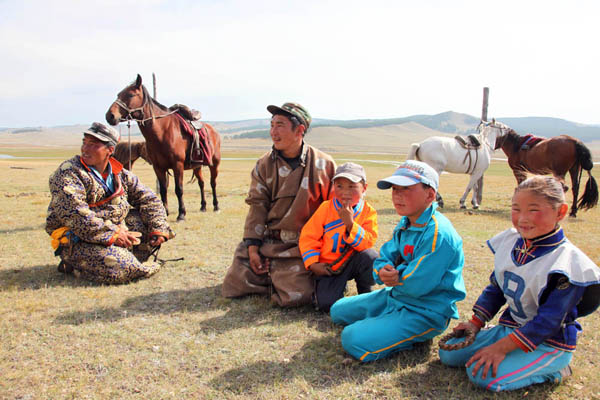
The children start to sing in mid-trot. Their high-pitched voices echo across the lonely steppe. Our interpreter Molor explains, “they’re worshipping their sky father and giving thanks to the horse.” It’s a haunting chorus that ebbs and flows with intensity as they amble past.
My husband, our two good friends and I are at the beginning of a 19-day horse riding adventure, where we’ll trek deep within the remote Darhat Valley, only accessible by horse, reindeer or foot. We are in search of the Tssatan people, nomadic reindeer herders, and getting a taste of a nomad’s life. To get here in time to see Naadam festivities, we jumped on an overnight train, hitched a ride on a regional flight and spent half a day in a Russian army van to reach the windswept town of Khatgal. It’s the frontier town to Lake Khovsgol National Park, the deepest lake in central Asia.
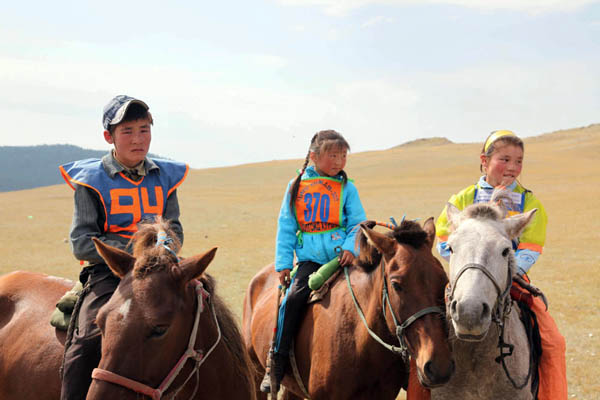
Naadam is a traditional type of festival in Mongolia held in country towns like Khatgal during the midsummer holidays. Translated as ‘the three games of men’, it includes Mongolian wrestling, horse racing and archery.
The dust cloud on the steppe signifies that the 25 kilometer, approximately 15 mile, horse race has begun. Molor tells us that a jockey’s age ranges from 6 to 11 and the length of race depends on the horses’ ages. As the brigade of galloping horses races towards the finish line, we see number nine, the twiggy Mongol girl, as the front-runner. She screams while whipping her bay pony on the rump. The pony’s creamed in sweat, nostrils flaring with exertion. She spurts across the finish line to a cheering crowd.
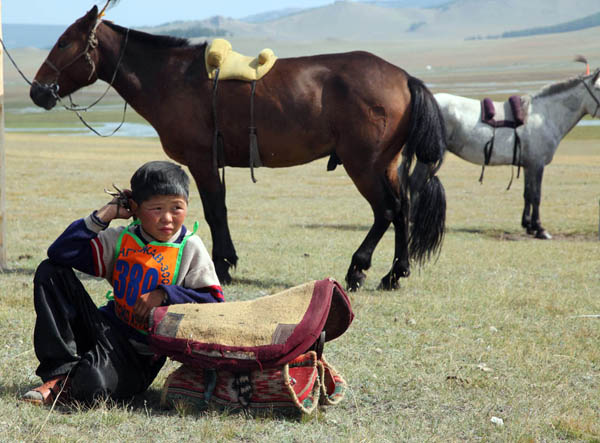
From Jigleg and Majestic Lake Khovsgol to Darhat Valley
The next day under the cover of darkness, after a cozy overnight stay in a traditional ger, a round, cone-shaped portable tent, with a roaring fire, we squeeze into a tiny motorboat for a four-hour trip north to the remote outpost of Jigleg. In the early morning light the lake is vast and limitless, stretching towards the Russian border. The great Siberian taiga forest marches to the lake’s edge.

The first time we saw the lake was after five hours in a van wrestling the Mongolian roads, and we were sticky with sweat and dust. The majestic Lake Khovsgol was a sparkling azure oasis with her clear river stone bottom. We couldn’t help but test the waters. Upon entry, I am rendered breathless by the water, my lungs shrink to the size of golf balls and I hear my bones snap, freezing from the cold.

Upon arriving at the remote outpost of Jigleg, consisting of a rickety, lakeside timber building, we’re introduced to our head horseman Danzan. He’s a toothless, smiling man with a grubby face dressed in the traditional del, a knife tucked into his sash belt and a felt hat perched loosely on his head. The del is an ankle-length coat girdled with a sash and became extremely useful throughout our trip. My borrowed del was used as a coat, blanket, card table and as cushioning against the uncomfortable saddles.
.jpg)
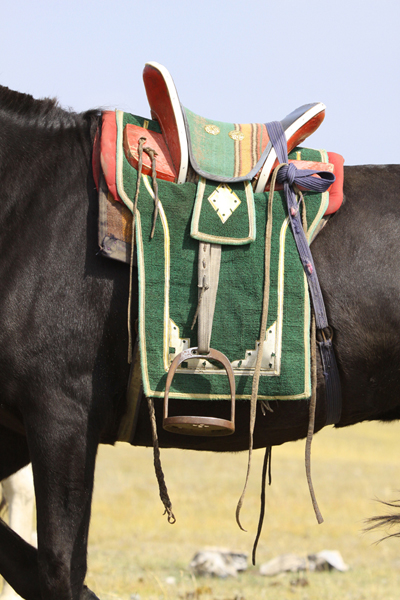
Danzan’s herd of horses is a ratty bunch of pint-sized geldings, no more than 14 hands high, their manes and forelocks cropped like mohawks. Molor tells us: “These horses are half wild. Never touch their neck as this is the wild part of the horse.” The mares with foals are kept at home so they can be milked to make Mongolia’s traditional drink airag, fermented mare’s milk.
.jpg)
The day we travelled from Muren to Khatgal a local Mongolian family offered us airag. The airag was ladled out of a large timber vat that sat at the entrance to the ger, bubbling with fermentation. It fizzed and buzzed on my tongue and tasted like curdled, natural yogurt.
Our riding posse of seven leaves Jigleg mid-afternoon and heads west into the heart of the remote Darhat Valley. Once we’re used to our mounts -- mine a wily, bay gelding whom I’ve fondly nicknamed Monkey Magic -- the group falls into a fast-paced trot. Unfortunately my horse doesn’t resemble a magic carpet and quite often I have to shout ‘Choo Choo.’ This is a typical expression used by a nomad to gee up his stead.
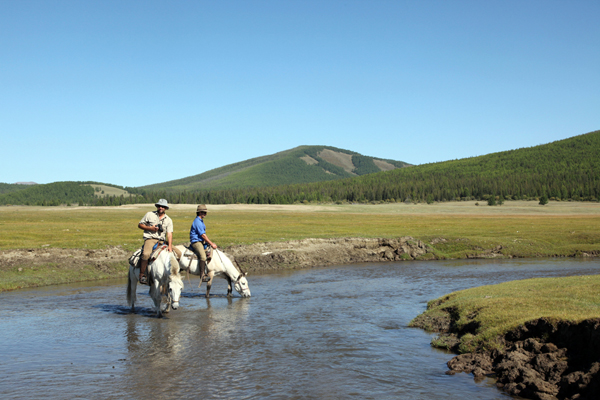
Over the course of the afternoon we tiptoe through dense forests of Siberian larch trees, skid down hills and cross dry river beds that are cavernous and echo with our footsteps. At one point the ground starts to shake like jelly and the horses sink to their knees. It’s a peat bog. The horses expertly navigate the sodden ground without hesitation.
Throughout the afternoon we tail behind a Mongolian family travelling in horse and cart and on horseback. That night we strike up a conversation with the family via our guide Molor, while nursing steaming cups of milky tea around the fire. The family has been cutting grass and building hay stacks at their winter property in preparation for the cold season. They’ll return to this region in November with their stock to survive Mongolia’s frigid winter. Molor explains that last year’s winter was devastating to families in the region, who lost the majority of their stock.

The following morning a heavy frost blanket covers the grass as the sun hides behind the mountain. The men of the Mongolian family camped under their wagon with only their del as protection against the cold. I shiver to think of surviving winter in the Darhat valley considering this is autumn. Here I am sheathed in my thermals, silk liner, cocooned in my minus 20-degree sleeping bag, and I’m adequately warm.
By late afternoon the forest stops and the golden steppe takes over, littered with wild flowers. We pass Mongols who live in the nearby town of Renchinlkhumbe who have walked, ridden or motor biked into the forest to pick the wild blueberries that carpet the floor. At lunchtime we nibble on blueberries until our bellies bloat and our fingers and tongues are stained purple.
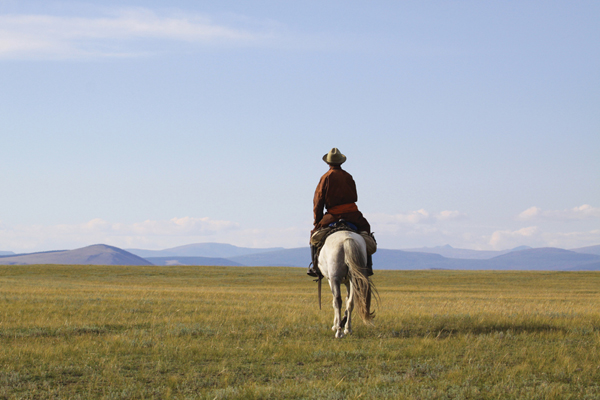
At dusk, we arrive at our ger camp, situated within the dusty streets of Renchinlkhumbe, peel off our chaps, shower and hit the town. There aren’t any streets or roads but dirt tracks that weave between the timber log houses that are painted fire truck red with blue trim. In the town center scrawny dogs sniff our legs. There are no cars to be seen. The main modes of transport due to poor roads are motorbikes and horses. I’ve seen a family of four with a goat on board a motorbike zoom past our riding group. We pass one shop where a chestnut horse stands obediently at the door, his lead rope escaping into the shop. Seconds later a young boy no older than five with a handful of sweets comes out of the shop, jumps on his mount and canters away.
Searching for the Reindeer Herders
For the next two days we ride deep within the Taiga of northern Mongolia in search of the nomadic Tsaatan. The Tsaatan’s identity and origin lies with the reindeer, and we’ll have an opportunity to live alongside them. Molor explains that the community regularly moves between the east and west Taiga in search of optimal grazing for their reindeer. We say farewell to the steppe and climb into the vast, roadless northern Taiga shaped by mountain ranges, forest, rock, marsh and rivers. The first night we ride until 7:30pm under a sky pinpricked with stars and set up camp beside a mountain stream. The tents are quickly assembled, the firewood collected and the vodka uncapped. In the dead of night, I hear the lonely howl of a wolf. His call echoes through camp.

The following morning we ride into a bare, sweeping valley of marshy tundra. The group instinctively falls into single file behind Danzan, who navigates his buckskin tentatively through the mud.
After a couple of hours, I look up to see a herd of reindeer scattered throughout the valley. Their chocolate, white and grey coats are barely visible against the muted colors of the tundra. A village of tepees sits staggered on the hillside; smoke blows from their conical chimneys. As we ride closer, I’m amazed by the agility and elegance of the reindeer. While my horse Monkey Magic is sinking into the sodden ground, the reindeer hardly leave a footprint in the mud. They glide over creek crossings and canter across the uneven, sinking ground. Its no wonder the Tsaatan choose to ride the reindeer with their smooth gait and gentle disposition.
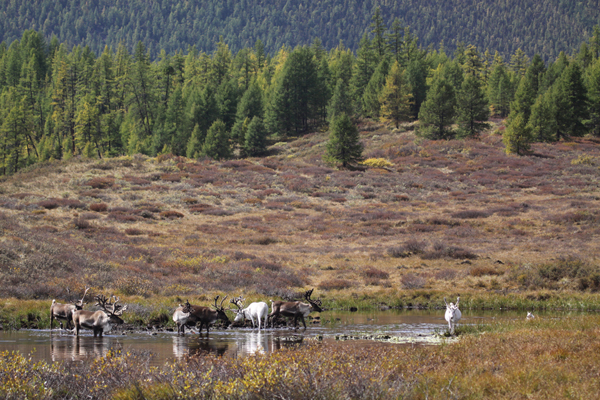
As a group, we erect our tents between tethered reindeer calves and tepees. Our campsite is elevated and dry, offering a spectacular view of the mountain stream and valley below. We make friends with a young Tsaatan couple, Zaya and PJ, who live on the forest’s edge. Zaya is Mongolian and was schooled in America, so we’re able to speak with her at length about her life.
For two days Zaya and PJ provide us with a glimpse into their life. In the early morning, we crawl from our warm sleeping bags to help milk the reindeers. My fingers fumble clumsily over the small teats. The milk is then used to make a crumbly, sharp cheese that hangs from the roof of their tepee and a salty milk tea. Once the milking is finished, the cows and bulls are left to graze the tundra while the calves remain tethered. It’s an unusual site to see the reindeers wander off with plastic bags tied to their antlers. Zaya explains, “We tie plastic bags to their antlers so we can determine which reindeer belongs to which family.”
.jpg)
We nuzzle and feed the calves salt treats while stroking their velvet fur. The calves are released a short time later to graze near camp now that their mothers are out of sight. Throughout the day a small group from the community perches on the hill and keeps reindeer watch, making sure they don’t wander into the nearby forest or fall prey to wolves.
I learn that the reindeer and Tsaatan share an interdependent and spiritual relationship, relying on each other to live in this harsh, unforgiving land. The reindeer rely on the Tsaatan for protection against predators, selection of grazing pastures and salt treats. The Tsaatan rely on the reindeer for transport and milk. The community’s ancient tradition of shamanism largely precludes the slaughter of reindeer by placing sacred value on the animal. Zaya tells us its only when a reindeer is killed by a predator that they’ll use the skin for boots or rugs.
During the day we help Zaya make a large, round loaf of bread that is cooked on the fireplace that sits in the centre of the tepee. She explains that their diet is very simple, consisting of bread and sugar for breakfast washed down with salty tea and bread and cheese throughout the day. Meat is a rarity because hunting is illegal in Mongolia. Daily life is slow and simplistic.
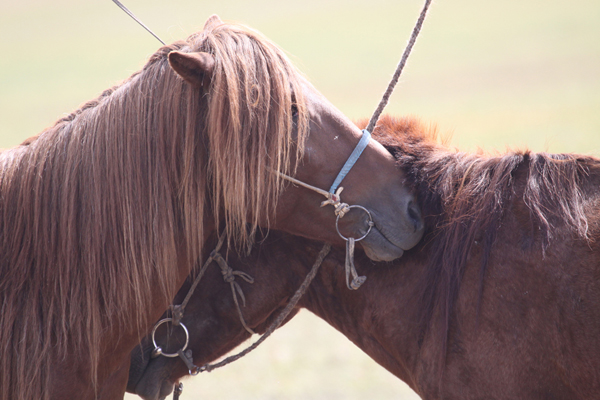
Once the morning chores are complete there is plenty of time to sit and talk. The autumn days are surprisingly warm. The four of us find a pool in the clear running mountain stream that is deep enough for an ice bath. It’s a brief plunge in the frigid water before leaping out onto the bank. The day passes by sitting on the grass playing cards for hours in the company of grazing reindeers under a cloudless sky.
The following day we bid a sad farewell to the Tsaatan community that had welcomed us. Just before we reach our final camp, Danzan, our toothy wrangler pulls out a bottle of Chinggis Vodka from beneath his del and we each take a hearty slug. I toast to Mongolia, home of the rosy-cheeked Mongols who were generous and hospitable and the wild-eyed, brave horses that carried us through sinking peat bogs and across the vast steppe.
Choo choo!
About the Author: Kate Johns is a horse wanderer, dreamer, lover, writer and photographer who has an insatiable appetite for exploring foreign cultures and unexplored lands from the back of a horse. Alongside her husband, Kate travels the globe documenting horse riding adventures. Learn more at globetrotting1.wordpress.com




